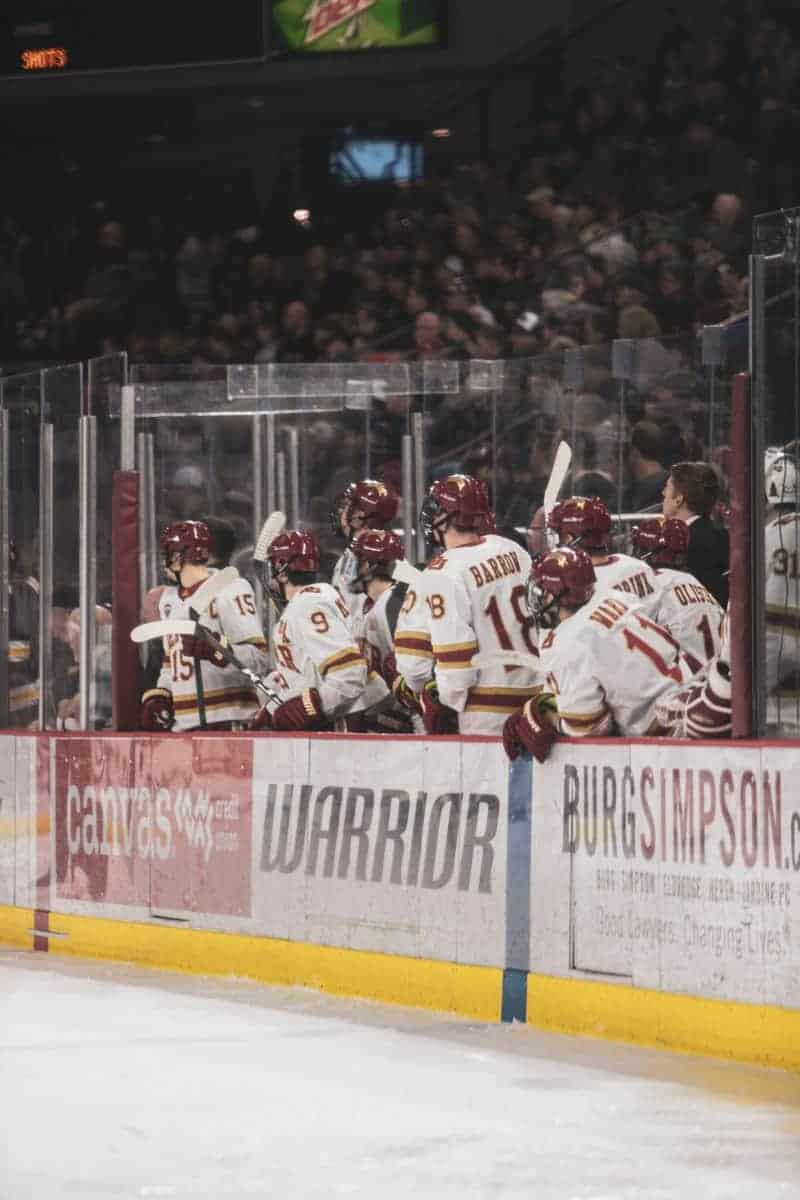When I watch a hockey game, seeing a player jump over the boards from their seat on the bench can be confusing. We will explore how shifts work to understand where the correct placement for each player is on the bench.
Hockey players sit next to their teammates going out on the ice at the same time. When they are not on the ice and seated on the bench, players talk strategy and receive advice from the coaching staff. The bench is divided into 2 sections; defense on one side and the forwards on the other. The defense sits on the side of the bench closest to their own goaltender.
Hockey players sitting in the correct spot on the bench is important but changing quickly and at the right time greases the machine as well. So how do they know when to jump onto the ice and come back to the bench?
On and Off- How do Players Know When to Change?
The coaches will instruct what players are up next. 5 players grouped together is called a line. The coach will yell out which line is up next, usually identified by a number or one player that is the leader of that line. Each player waiting to jump on the ice will say the name of the player they are switching with on the next shift change. This is necessary because if 2 players jump on the ice for 1 player coming out of the game, the result will be a penalty.
To avoid running into each other, players going in jump over the boards, and the players coming off the ice enter through the small gates at each end of the bench. If time is crucial, or there is about to be a ‘too many men on the ice’ penalty, players coming off the ice will jump over the boards onto the bench, as it is quicker than pushing the gate door open and stepping into the bench area.
Sit or Stand Between Shifts- Which is Best?
The time on the bench is a very important part of the game. Because players are on the ice for such a short time, their muscles need time to recoup strength before going hard again. Hockey consists of such short, bursts of speed, so slowing their breathing down on the bench is important. Obviously, sitting down allows your body to recoup muscle strength faster and allows breathing to slow down quicker as well. Coaches can access and talk to players more effectively when they are sitting rather than standing.
The other side to the argument is standing rather than sitting, which does not allow toxins to build up in the muscles, or what commonly known as letting your muscles get ‘tight.’ Players playing on the fourth line or not as much as the top lines, need to stand up during the game to make sure they are warmed up and ready to go when their number is called. Standing allows for your blood to flow and keep your body in game-ready condition. A player needs to know how much playing time they will have during the game, so they can act accordingly on the bench.
There is not a right or wrong answer here, but most coaches instruct players to sit for logistical reasons as we will discuss next in this article. Players at higher levels know their bodies and when to stand if needed to get the blood flowing and warm up their muscles.
Who Controls All the Changes?
Coaches. In the top leagues with multiple coaches, you will see the head coach controlling either the defenseman or forwards, not both. With everything in the game to manage (yelling at the referees, player time management, in-game change, etc.), the head coach only has the capacity to manage either the defense or forwards. Younger leagues only have 1 coach, thus forcing the coach to handle the whole bench.
Coaches spend hours before every game dialoguing through what players will be skating together. They sit through many meetings discussing not only what players will play together, but which of their own players match up well against the other teams’ players. Throughout the game, coaches will mix up players based on input from other staff, giving their team the best chance to win.
The coach will make the call of which pair of defense and which threesome of forwards are going into the game next. Constant communication between staff ensures the next 5 players on the ice give the team the best chance to win the game in the end. Coaches can easily access the players after their shift when they sit together.
When Can You Change Lines in Hockey?
During live play, players can jump on and off the ice at their discretion. The older the players are in the league the more strategy there is in play. Coaches will establish what is known as a checking line to play against the best offensive line from the other team. As discussed earlier, there is a skill and an art to changing at the right time during play.
When the puck is not in play both teams can change. Who changes last? Glad you asked. The team assigned as ‘home’ team gets the last word. This gives the home team a distinct advantage as they can see what players the visiting team puts on the ice, and match up accordingly. However, if the visiting team always places the best scoring players on the ice, and the home team counters with their top defensive team, one could argue the home team does not have good scoring chances. The referees govern this process. If they feel like either team is taking to long and delaying the game flow, they can disallow a change to occur.
There are few times a team cannot change when the puck is not in play. At the referee’s discretion, if a team is taking to long to change, they may not allow them to change. The more common situation is when icing is called on the offensive team. The only time this operation is not allowed is when the puck is blown dead for icing.
How Long Is a Player on the Ice?
Much to the surprise of new fans, players are only on the ice for 30 to 40 seconds at a time. This is what is known as a shift. For an entire game, a player is on the ice for about 18 to 20 minutes. Many factors affect how long a player is on the ice throughout the game, pushing some players well past the 20-minute mark, while pushing some playing time down below 10 minutes. The younger the league, the more even every player’s time will be. It does take a while for very young players to understand shifts and how quickly to get on and off the ice.
How Many Players Sit on the Bench?
Most teams consist of 4 forward lines and 3 pairs of defense. Depending on personnel availability and coaching style, the forward and defense combination could change. There is a total of 18 skaters for a game and 2 goalies. With 5 players and 1 goalie on the ice at a time, that leaves for 13 skaters, 1 goalie, and the coaching staff to be in the bench area. In some arenas, you will see the backup goalie sitting elsewhere, because of the lack of space on the bench.

